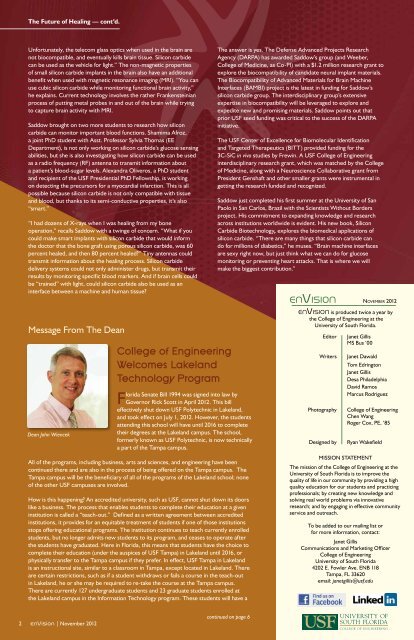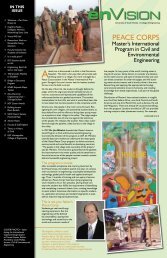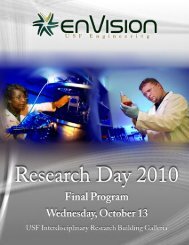envision - College Of Engineering - University of South Florida
envision - College Of Engineering - University of South Florida
envision - College Of Engineering - University of South Florida
You also want an ePaper? Increase the reach of your titles
YUMPU automatically turns print PDFs into web optimized ePapers that Google loves.
The Future <strong>of</strong> Healing — cont’d.Unfortunately, the telecom glass optics when used in the brain arenot biocompatible, and eventually kills brain tissue. Silicon carbidecan be used as the vehicle for light.” The non-magnetic properties<strong>of</strong> small silicon carbide implants in the brain also have an additionalbenefit when used with magnetic resonance imaging (MRI). “You canuse cubic silicon carbide while monitoring functional brain activity,”he explains. Current technology involves the rather Frankensteinianprocess <strong>of</strong> putting metal probes in and out <strong>of</strong> the brain while tryingto capture brain activity with MRI.Saddow brought on two more students to research how siliconcarbide can monitor important blood functions. Shamima Afroz,a joint PhD student with Asst. Pr<strong>of</strong>essor Sylvia Thomas (EEDepartment), is not only working on silicon carbide’s glucose sensingabilities, but she is also investigating how silicon carbide can be usedas a radio frequency (RF) antenna to transmit information abouta patient’s blood-sugar levels. Alexandra Oliveros, a PhD studentand recipient <strong>of</strong> the USF Presidential PhD Fellowship, is workingon detecting the precursors for a myocardial infarction. This is allpossible because silicon carbide is not only compatible with tissueand blood, but thanks to its semi-conductive properties, it’s also“smart.”“I had dozens <strong>of</strong> X-rays when I was healing from my boneoperation,” recalls Saddow with a twinge <strong>of</strong> concern. “What if youcould make smart implants with silicon carbide that would informthe doctor that the bone graft using porous silicon carbide, was 60percent healed, and then 80 percent healed?” Tiny antennas couldtransmit information about the healing process. Silicon carbidedelivery systems could not only administer drugs, but transmit theirresults by monitoring specific blood markers. And if brain cells couldbe “trained” with light, could silicon carbide also be used as aninterface between a machine and human tissue?Message From The DeanDean John Wiencek<strong>College</strong> <strong>of</strong> <strong>Engineering</strong>Welcomes LakelandTechnology Program<strong>Florida</strong> Senate Bill 1994 was signed into law byGovernor Rick Scott in April 2012. This billeffectively shut down USF Polytechnic in Lakeland,and took effect on July 1, 2012. However, the studentsattending this school will have until 2016 to completetheir degrees at the Lakeland campus. The school,formerly known as USF Polytechnic, is now technicallya part <strong>of</strong> the Tampa campus.All <strong>of</strong> the programs, including business, arts and sciences, and engineering have beencontinued there and are also in the process <strong>of</strong> being <strong>of</strong>fered on the Tampa campus. TheTampa campus will be the beneficiary <strong>of</strong> all <strong>of</strong> the programs <strong>of</strong> the Lakeland school; none<strong>of</strong> the other USF campuses are involved.How is this happening? An accredited university, such as USF, cannot shut down its doorslike a business. The process that enables students to complete their education at a giveninstitution is called a “teach-out.” Defined as a written agreement between accreditedinstitutions, it provides for an equitable treatment <strong>of</strong> students if one <strong>of</strong> those institutionsstops <strong>of</strong>fering educational programs. The institution continues to teach currently enrolledstudents, but no longer admits new students to its program, and ceases to operate afterthe students have graduated. Here in <strong>Florida</strong>, this means that students have the choice tocomplete their education (under the auspices <strong>of</strong> USF Tampa) in Lakeland until 2016, orphysically transfer to the Tampa campus if they prefer. In effect, USF Tampa in Lakelandis an instructional site, similar to a classroom in Tampa, except located in Lakeland. Thereare certain restrictions, such as if a student withdraws or fails a course in the teach-outin Lakeland, he or she may be required to re-take the course at the Tampa campus.There are currently 127 undergraduate students and 23 graduate students enrolled atthe Lakeland campus in the Information Technology program. These students will have aThe answer is yes. The Defense Advanced Projects ResearchAgency (DARPA) has awarded Saddow’s group (and Weeber,<strong>College</strong> <strong>of</strong> Medicine, as Co-PI) with a $1.2 million research grant toexplore the biocompatibility <strong>of</strong> candidate neural implant materials.The Biocompatibility <strong>of</strong> Advanced Materials for Brain MachineInterfaces (BAMBI) project is the latest in funding for Saddow’ssilicon carbide group. The interdisciplinary group’s extensiveexpertise in biocompatibility will be leveraged to explore andexpedite new and promising materials. Saddow points out thatprior USF seed funding was critical to the success <strong>of</strong> the DARPAinitiative.The USF Center <strong>of</strong> Excellence for Biomolecular Identificationand Targeted Therapeutics (BITT) provided funding for the3C-SiC in vivo studies by Frewin. A USF <strong>College</strong> <strong>of</strong> <strong>Engineering</strong>interdisciplinary research grant, which was matched by the <strong>College</strong><strong>of</strong> Medicine, along with a Neuroscience Collaborative grant fromPresident Genshaft and other smaller grants were instrumental ingetting the research funded and recognized.Saddow just completed his first summer at the <strong>University</strong> <strong>of</strong> SanPaolo in San Carlos, Brazil with the Scientists Without Bordersproject. His commitment to expanding knowledge and researchacross institutions worldwide is evident. His new book, SiliconCarbide Biotechnology, explores the biomedical applications <strong>of</strong>silicon carbide. “There are many things that silicon carbide cando for millions <strong>of</strong> diabetics,” he muses. “Brain machine interfacesare sexy right now, but just think what we can do for glucosemonitoring or preventing heart attacks. That is where we willmake the biggest contribution.”enVision November 2012enVision is produced twice a year bythe <strong>College</strong> <strong>of</strong> <strong>Engineering</strong> at the<strong>University</strong> <strong>of</strong> <strong>South</strong> <strong>Florida</strong>.EditorWritersPhotographyDesigned byJanet GillisMS Bus ‘00Janet DawaldTom EdringtonJanet GillisDesa PhiladelphiaDavid RamosMarcus Rodriguez<strong>College</strong> <strong>of</strong> <strong>Engineering</strong>Chen WangRoger Cox, PE, ‘85Ryan WakefieldMission StatementThe mission <strong>of</strong> the <strong>College</strong> <strong>of</strong> <strong>Engineering</strong> at the<strong>University</strong> <strong>of</strong> <strong>South</strong> <strong>Florida</strong> is to improve thequality <strong>of</strong> life in our community by providing a highquality education for our students and practicingpr<strong>of</strong>essionals; by creating new knowledge andsolving real world problems via innovativeresearch; and by engaging in effective communityservice and outreach.To be added to our mailing list orfor more information, contact:Janet GillisCommunications and Marketing <strong>Of</strong>ficer<strong>College</strong> <strong>of</strong> <strong>Engineering</strong><strong>University</strong> <strong>of</strong> <strong>South</strong> <strong>Florida</strong>4202 E. Fowler Ave. ENB 118Tampa, FL 33620email: janetgillis@usf.edu2 enVision | April November 2011 2012continued on page 6




